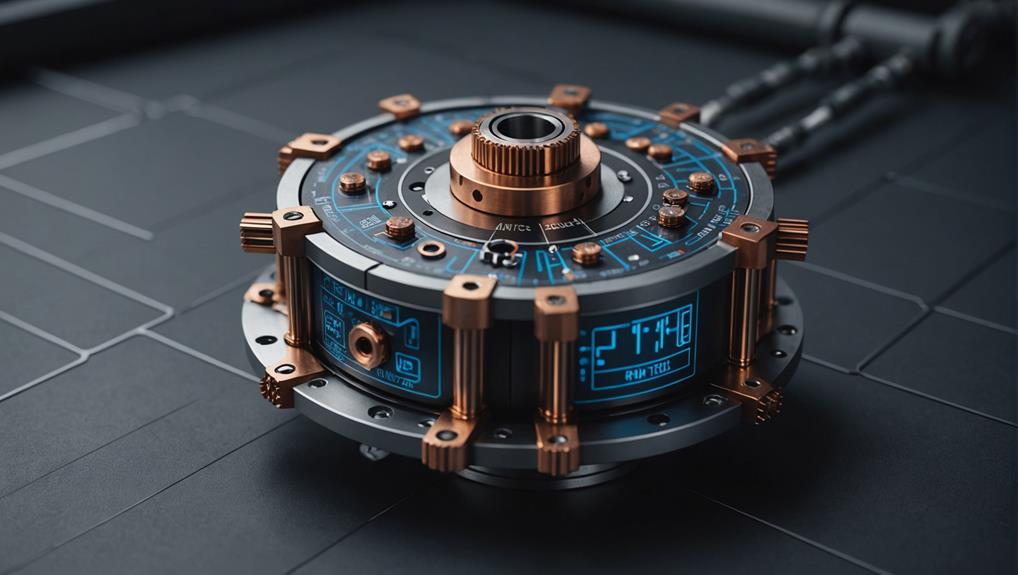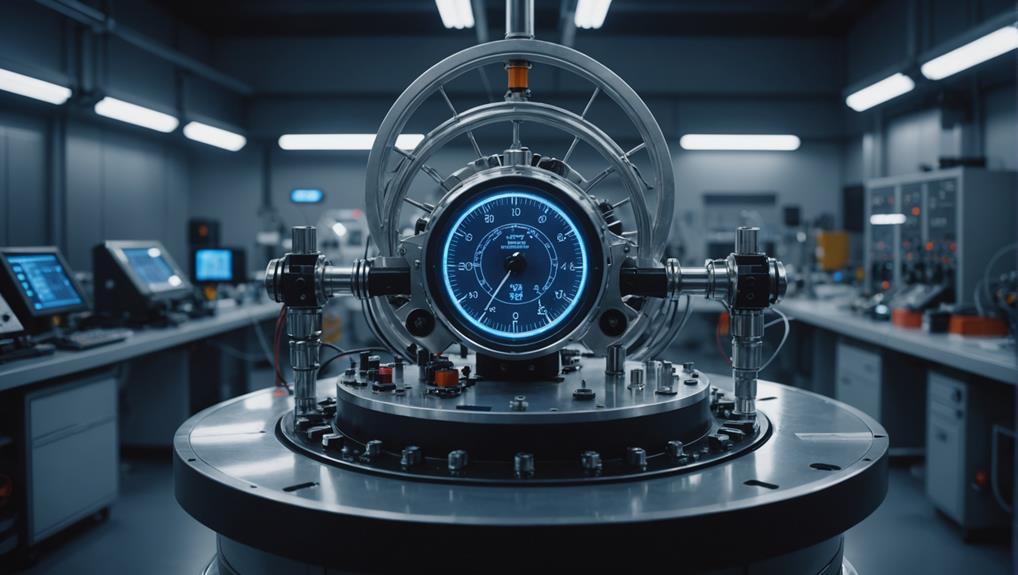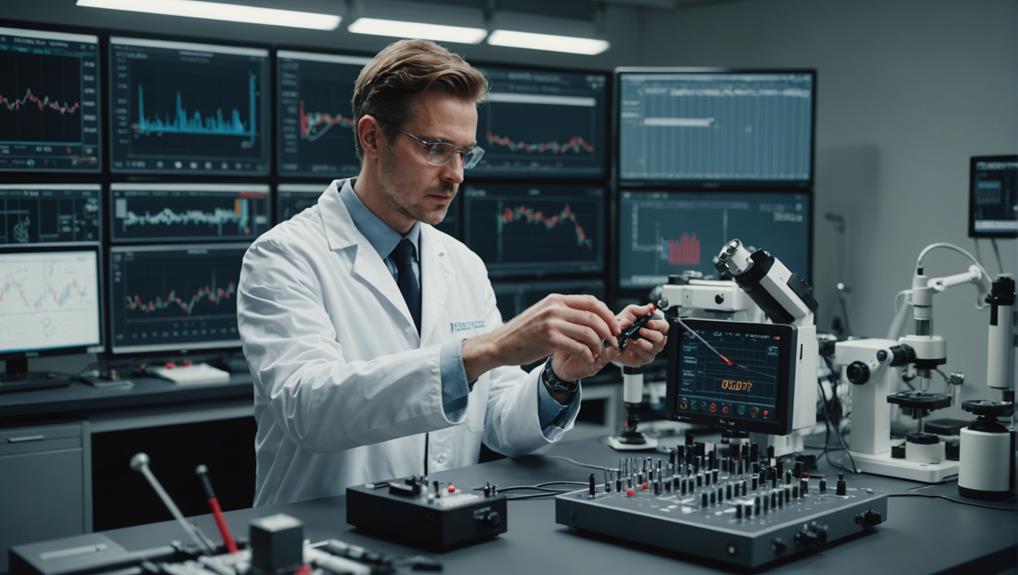
How Dynamometers Enhance Engine Diagnostics and Testing
Necessitating precise measurements, dynamometers unlock the secrets of engine performance, but what else can they reveal about engine diagnostics and testing?
Dynamometer technology is founded on the fundamental principle of measuring torque, power, and rotational speed of a rotating machine or engine through the absorption of mechanical energy and its conversion into a measurable force or torque.
Precise calibration is crucial for accurate measurement, with multiple methods existing for measuring torque, including strain gauge, piezoelectric, and hydraulic techniques.
Dynamometers come in diverse forms, catering to specific requirements and applications, and are used to test the performance and efficiency of engines, motors, and gearboxes.
The complex interplay of components, functionality, and data acquisition systems enables precise analysis and optimisation of machine performance.
Through accurate measurement and analysis, dynamometers facilitate the improvement of machine design, efficiency, and reliability.
Understanding dynamometer fundamentals is crucial to grasping the operation of this technology.
A dynamometer is a device designed to measure the torque, power, and rotational speed of a rotating machine or engine. It functions by absorbing the mechanical energy generated by the machine under test, converting it into a measurable force or torque, which allows for precise measurement of the machine's performance characteristics.
In the context of testing, a dynamometer serves as a load device, simulating real-world operating conditions to evaluate a machine's performance.
The calibration of the dynamometer is pivotal to securing accurate measurements, as it directly affects the reliability of the test results. Grasping these fundamental principles enables users to harness the full potential of dynamometer technology, revealing valuable insights into machine performance and efficiency.
Torque and power measurement principles are fundamental to dynamometer technology, as they enable the accurate assessment of a machine's performance.
There are different methods for measuring torque, including strain gauge, piezoelectric, and hydraulic techniques, each with its own advantages and limitations.
Accurate power calculation relies on the measurement of torque and angular velocity, emphasizing the importance of precise angular velocity measurement in dynamometer applications.
Torque Measurement Methods
Several approaches exist for measuring torque, each with its strengths and limitations.
The choice of method depends on the specific application, desired accuracy, and environmental conditions.
Strain gauge-based torque measurement involves bonding strain gauges to a torque sensor, which detects the deformation caused by the applied torque.
This method provides high sensitivity and accuracy, making it suitable for precision applications.
Eddy current dynamometers use an electromagnet to create an eddy current in a rotor, which generates a torque proportional to the rotational speed.
These dynamometers are commonly used in high-speed applications.
Absorption dynamometers absorb the energy produced by the device under test, converting it into heat.
The absorbed energy is directly proportional to the torque produced.
These dynamometers are often used in high-torque applications.
Prony brake dynamometer uses a mechanical brake to absorb the energy produced, measuring the torque through the frictional force applied to the brake.
This method is simple and effective, but may lack precision.
In dynamometer technology, accurate torque measurement is vital for reliable testing and analysis.
Selecting the appropriate torque measurement method guarantees precise and reliable results, ultimately leading to improved product design and performance.
Accurate torque measurement, as discussed earlier, is a fundamental aspect of dynamometer technology.
However, measuring power is also vital in understanding the performance of a machine or engine. In dynamometer technology, power is calculated as the product of angular velocity and torque (P = τ × ω), where τ is the torque and ω is the angular velocity in radians per unit time.
Dynamometers use torque transducers to convert mechanical torque into an electrical signal, and rotational speed is measured using tachometers or speed sensors. Conversion constants may be required depending on the units of measurement used, such as Newton-meters for torque and radians per unit time for angular velocity.
A data acquisition system collects and processes the torque and speed data, providing a real-time power output value. This enables accurate measurement of power absorption, which is vital in understanding the performance of a machine or engine.
Dynamometers can provide valuable insights into the efficiency and performance of a machine, enabling users to optimise their design and operation.
The spinning shaft of a machine or engine is a critical component in determining its power output, as it directly affects the angular velocity measurement.
The angular velocity of the rotating shaft is a fundamental parameter in measuring torque and rotational power. A dynamometer is used to measure the torque and angular velocity of the rotating prime mover, allowing for accurate power measurements.
The significance of angular velocity in dynamometer technology can be summarised in the following key points:
Dynamometers, versatile testing devices, come in diverse forms, each catering to specific requirements and applications.
The different types of dynamometers are designed to accommodate distinct power absorption capacities, making them suitable for a wide range of industries and testing scenarios.
Eddy current dynamometers, for example, are ideal for high-speed and high-torque applications, whereas AC dynamometers are better suited for testing electrical motors.
Universal dynamometers, in contrast, offer flexibility and can be used for multiple types of testing.
Dynamometer operation is typically dependent on load cells and strain gauges, which measure the applied force and deformation, respectively.
In terms of applications, dynamometers are used to test the performance and efficiency of engines, motors, and gearboxes.
They are also employed in the development of new electrical power systems and the improvement of existing ones.
The specific type of dynamometer used is often determined by the required power absorption capacity, testing speed, and torque measurement accuracy.
Accurate and reliable test results can be guaranteed through the selection of the appropriate type of dynamometer, ultimately leading to better product design and development.
Dynamometer Components and Functionality
The general performance and reliability of a dynamometer are contingent upon the quality and precision of its constituent components.
These components work in harmony to guarantee accurate measurement and control of the engine or machine being tested. A dynamometer's primary function is to absorb the power output of an engine or machine, allowing for the measurement of torque and rotational speed.
The following components are vital to dynamometer functionality:
The accuracy and reliability of dynamometer testing rely on sophisticated data acquisition and analysis systems.
These systems play a vital role in ensuring the precision and accuracy of test results.
A typical data acquisition system consists of two units: a Commander and Workstation, connected by an Ethernet cable.
The Workstation, a touch-screen operated unit, operates precision load and throttle control systems, collects data, and sends it to the Commander for processing, storage, and analysis.
The Commander, a desktop computer, processes, stores, and analyses the data, providing detailed insights into the performance and efficiency of the engine or motor under test.
Pressure transducers, such as the AccuSense Model ASM, measure airflow in the intake manifold, oil pressure, and other fluid pressures with high accuracy and precision in harsh testing environments.
The accuracy of the data acquisition system depends on the precision of its pressure transducers, which can withstand mechanical shock and vibration, thermal shock, corrosion, and other extremes.
Accurate pressure measurement enables the system to provide valuable insights into engine performance, allowing engineers to optimise design and improve total efficiency.
Accurate calibration and maintenance of dynamometers are critical to ensuring the reliability and precision of test results.
To achieve this, calibration procedures must be meticulously followed, regular maintenance schedules adhered to, and precise instrument adjustments made to prevent errors and drift.
In any testing scenario, verifying the precision of measurement tools is paramount, and dynamometer calibration is no exception.
Calibration involves comparing the device's measurements to a reference standard to guarantee accuracy, with a typical calibration tolerance of ±0.5% to ±11.0% of full scale.
This process is vital to maintain dynamometer accuracy, as it directly impacts the reliability of test data.
Calibration procedures typically comprise a series of tests to verify the dynamometer's torque measurement capabilities, validating precise capture of rotational force.
These tests also confirm accurate capture of rotational velocity, certifying accurate capture of energy output, and ability to accurately capture transient events, such as sudden changes in torque or speed.
Proper documentation of calibration procedures and results is critical to guaranteeing the integrity of test data and maintaining compliance with industry standards and regulations.
Users can trust the accuracy and precision of their dynamometer measurements, ultimately leading to reliable testing results, if they follow established calibration procedures.
Regular maintenance schedules are integral to ensuring dynamometers remain in optimal working condition, guaranteeing the accuracy and reliability of test data.
A routine of daily, weekly, and monthly checks identifies and addresses any issues, such as worn or damaged components, corrosion, or software malfunctions. Calibration, typically every 6-12 months or as specified by the manufacturer, is vital to verify accuracy and precision.
Regular inspection and maintenance of lubrication and cooling systems prevent overheating, which can lead to inaccurate measurements and equipment damage.
Dynamometer sensors and transducers must be cleaned and inspected regularly to prevent contamination and guarantee accurate data acquisition. A thorough maintenance log tracks all maintenance activities, calibration records, and any repairs or replacements, ensuring the dynamometer remains in optimal working condition.
This maintenance regime maintains control systems and software integrity, guaranteeing the precision of test results.
Calibration and maintenance procedures are vital to ensuring the precision of dynamometer measurements, guaranteeing accurate and reliable data in industries such as aerospace and automotive testing.
To achieve optimal performance, dynamometers require precise adjustments and regular inspections.
These include:
The landscape of dynamometer technology has undergone a significant transformation in recent years, driven by breakthroughs in digital control systems, artificial intelligence, and advanced sensing technologies.
These advancements have transformed dynamometers into more accurate and reliable tools for power and torque measurements. Real-time data acquisition and processing enable swift absorption of electrical signals, allowing for efficient testing and analysis.
The integration of artificial intelligence and machine learning optimises testing protocols, improves data analysis, and predicts potential failures, reducing downtime and increasing total efficiency.
Refined sensing technologies, such as advanced strain gauges and optical sensors, augment precision in dynamometer measurements, reducing measurement errors and improving calibration techniques.
These innovations have boosted the role of dynamometers in multiple industries, enabling versatile testing setups, remote monitoring, and field applications in aerospace, automotive, and renewable energy.
As a result, dynamometers have become indispensable tools for precise and reliable measurements, driving progress in multiple fields.
Hyper Power plays a crucial role in providing accurate torque and power measurements across various industrial and research applications. To ensure precise measurement and analysis, it is essential to understand the fundamental principles, types, and components of dynamometers. Advances in dynamometer technology have enhanced precision and expanded its applications. To guarantee reliable and consistent results, proper calibration and maintenance procedures are vital. As technology continues to evolve, Hyper Power remains committed to optimising performance and efficiency in diverse fields. If you have any questions about our customised services, including Custom Dyno Solutions, Installation and Setup, Training and Certification, Technical Support and Maintenance, Software Updates and Upgrades, Diagnostics and Performance Analysis, Rental Services, Dynamometer Testing Services, and Accessories and Parts, please do not hesitate to contact us.

Necessitating precise measurements, dynamometers unlock the secrets of engine performance, but what else can they reveal about engine diagnostics and testing?

Navigating the complexities of torque measurement requires a deep understanding of the underlying principles and mechanisms to ensure accurate results.

Precise control and optimization of engine performance await, but only for those who unlock the secrets of dynamometer-driven data analysis.

Gaining insight into the differences between inertia and brake dynamometers is crucial for ensuring accurate testing results in various industries.

Tapping into the precise measurement capabilities of dynamometers, uncover the secrets to optimizing fuel efficiency and slashing emissions in the automotive industry.

Witness the importance of rigorous safety protocols and best practices in dynamometer testing to avoid catastrophic failures and ensure accurate results.

Harnessing the nuances of precision measurement is crucial to avoiding costly errors in dynamometer testing, but what are the key factors to consider?

Witness the transformative power of dynamometers in unlocking your vehicle’s hidden performance potential, but only if you know how to harness their precision.